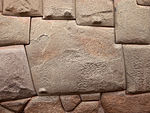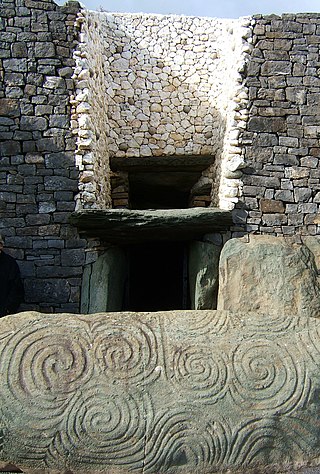
Archaeoastronomy is the interdisciplinary or multidisciplinary study of how people in the past "have understood the phenomena in the sky, how they used these phenomena and what role the sky played in their cultures". Clive Ruggles argues it is misleading to consider archaeoastronomy to be the study of ancient astronomy, as modern astronomy is a scientific discipline, while archaeoastronomy considers symbolically rich cultural interpretations of phenomena in the sky by other cultures. It is often twinned with ethnoastronomy, the anthropological study of skywatching in contemporary societies. Archaeoastronomy is also closely associated with historical astronomy, the use of historical records of heavenly events to answer astronomical problems and the history of astronomy, which uses written records to evaluate past astronomical practice.

Tikal is the ruin of an ancient city, which was likely to have been called Yax Mutal, found in a rainforest in Guatemala. It is one of the largest archeological sites and urban centers of the pre-Columbian Maya civilization. It is located in the archeological region of the Petén Basin in what is now northern Guatemala. Situated in the department of El Petén, the site is part of Guatemala's Tikal National Park and in 1979 it was declared a UNESCO World Heritage Site.

Uxmal is an ancient Maya city of the classical period located in present-day Mexico. It is considered one of the most important archaeological sites of Maya culture, along with Palenque, Chichen Itza and Calakmul in Mexico, Caracol and Xunantunich in Belize, and Tikal in Guatemala. It is located in the Puuc region of the western Yucatán Peninsula, and is considered one of the Maya cities most representative of the region's dominant architectural style. It has been designated a UNESCO World Heritage Site in recognition of its significance.

Mesoamerican chronology divides the history of prehispanic Mesoamerica into several periods: the Paleo-Indian ; the Archaic, the Preclassic or Formative (2500 BCE – 250 CE), the Classic (250–900 CE), and the Postclassic (900–1521 CE); as well as the post European contact Colonial Period (1521–1821), and Postcolonial, or the period after independence from Spain (1821–present).

Cival is an archaeological site in the Petén Basin region of the southern Maya lowlands, which was formerly a major city of the Pre-Columbian Maya civilization. It is located in the present-day Department of Petén, Guatemala.

Mesoamerican pyramids form a prominent part of ancient Mesoamerican architecture. Although similar in some ways to Egyptian pyramids, these New World structures have flat tops and stairs ascending their faces. The largest pyramid in the world by volume is the Great Pyramid of Cholula, in the east-central Mexican state of Puebla. The builders of certain classic Mesoamerican pyramids have decorated them copiously with stories about the Hero Twins, the feathered serpent Quetzalcoatl, Mesoamerican creation myths, ritualistic sacrifice, etc. written in the form of Maya script on the rises of the steps of the pyramids, on the walls, and on the sculptures contained within.

El Castillo, also known as the Temple of Kukulcan' is a Mesoamerican step-pyramid that dominates the center of the Chichen Itza archaeological site in the Mexican state of Yucatán. The temple building is more formally designated by archaeologists as Chichen Itza Structure 5B18.
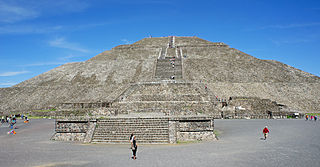
The Pyramid of the Sun is the largest building in Teotihuacan, and one of the largest in Mesoamerica. It is believed to have been constructed about 200 AD. Found along the Avenue of the Dead, in between the Pyramid of the Moon and the Ciudadela, and in the shadow of the mountain Cerro Gordo, the pyramid is part of a large complex in the heart of the city.

Maya architecture spans several thousands of years, several eras of political change, and architectural innovation before the Spanish colonization of the Americas. Often, the buildings most dramatic and easily recognizable as creations of the Maya peoples are the step pyramids of the Terminal Preclassic Maya period and beyond. Based in general Mesoamerican architectural traditions, the Maya utilized geometric proportions and intricate carving to build everything from simple houses to ornate temples. This article focuses on the more well-known pre-classic and classic examples of Maya architecture. The temples like the ones at Palenque, Tikal, and Uxmal represent a zenith of Maya art and architecture. Through the observation of numerous elements and stylistic distinctions, remnants of Maya architecture have become an important key to understanding their religious beliefs and culture as a whole.

Mesoamerica is a historical region and cultural area that begins in the southern part of North America and extends to most of Central America, thus comprising the lands of central Mexico, Belize, and Guatemala, El Salvador, Honduras, and Nicaragua, and northern Costa Rica. In the pre-Columbian era, many societies flourished in Mesoamerica for more than 3,000 years before the Spanish colonization of the Americas begun at Hispaniola island in 1493. In world history, Mesoamerica was the site of two historical transformations: (i) primary urban generation, and (ii) the formation of New World cultures from the mixtures of the indigenous Mesoamerican peoples with the European, African, and Asian peoples who were introduced by the Spanish colonization of the Americas.

Mesoamerican architecture is the set of architectural traditions produced by pre-Columbian cultures and civilizations of Mesoamerica, traditions which are best known in the form of public, ceremonial and urban monumental buildings and structures. The distinctive features of Mesoamerican architecture encompass a number of different regional and historical styles, which however are significantly interrelated. These styles developed throughout the different phases of Mesoamerican history as a result of the intensive cultural exchange between the different cultures of the Mesoamerican culture area through thousands of years. Mesoamerican architecture is mostly noted for its pyramids, which are the largest such structures outside of Ancient Egypt.
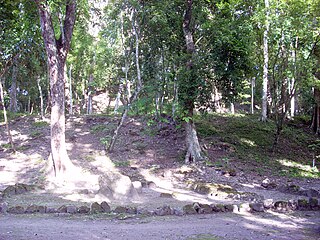
Ixlu is a small Maya archaeological site that dates to the Classic and Postclassic Periods. It is located on the isthmus between the Petén Itzá and Salpetén lakes, in the northern Petén Department of Guatemala. The site was an important port with access to Lake Petén Itzá via the Ixlu River. The site has been identified as Saklamakhal, also spelt Saclemacal, a capital of the Kowoj Maya.

El Zotz is a Mesoamerican archaeological site of the pre-Columbian Maya civilization, located in the Petén Basin region around 20 kilometres (12 mi) west of the major center of Tikal and approximately 26 kilometres (16 mi) west of Uaxactun. It is so called because of the large number of bats living in caves in the nearby cliffs. The site is located within the San Miguel la Palotada National Park bordering the Tikal National Park in the present-day department of Petén, Guatemala. It is a large Classic Period site and contains many unexcavated mounds and ruins.

The Maya civilization was a Mesoamerican civilization that existed from antiquity to the early modern period. It is known by its ancient temples and glyphs (script). The Maya script is the most sophisticated and highly developed writing system in the pre-Columbian Americas. The civilization is also noted for its art, architecture, mathematics, calendar, and astronomical system.

Triadic pyramids were an innovation of the Preclassic Maya civilization consisting of a dominant structure flanked by two smaller inward-facing buildings, all mounted upon a single basal platform. The largest known triadic pyramid was built at El Mirador in the Petén Basin of Guatemala; it covers an area six times as large as that covered by Tikal Temple IV, which is the largest pyramid at that city. The three superstructures all have stairways leading up from the central plaza on top of the basal platform. Triadic pyramid structures are found at early cities in the Maya lowlands.
An astronomical complex or commemorative astronomical complex is a series of man-made structures with an astronomical purpose. It has been used when referring to a group of Megalithic structures that it is claimed show high precision astronomical alignments. For the study of Archaeoastronomy, such complexes of similar structures are required for adequate measurement and calculation to ensure that similar celestial sightlines were intended by the designers. These arrangements have also been known as observational, ceremonial or ritual complexes with importance for the study of prehistoric cultures.

Maya astronomy is the study of the Moon, planets, Milky Way, Sun, and astronomical phenomena by the Precolumbian Maya Civilization of Mesoamerica. The Classic Maya in particular developed some of the most accurate pre-telescope astronomy in the world, aided by their fully developed writing system and their positional numeral system, both of which are fully indigenous to Mesoamerica. The Classic Maya understood many astronomical phenomena: for example, their estimate of the length of the synodic month was more accurate than Ptolemy's, and their calculation of the length of the tropical solar year was more accurate than that of the Spanish when the latter first arrived. Many temples from the Maya architecture have features oriented to celestial events.
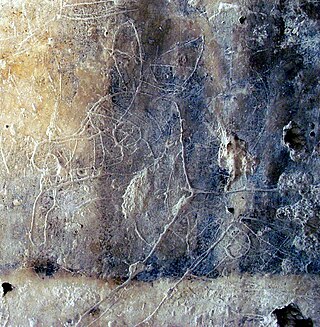
Ancient Maya graffiti are a little-studied area of folk art of the pre-Columbian Maya civilization. Graffiti were incised into the stucco of interior walls, floors, and benches, in a wide variety of buildings, including pyramid-temples, residences, and storerooms. Graffiti have been recorded at over 50 Maya sites, particularly clustered in the Petén Basin and southern Campeche, and the Chenes region of northwestern Yucatán. At Tikal, where a great quantity of graffiti have been recorded, the subject matter includes drawings of temples, people, deities, animals, banners, litters, and thrones. Graffiti were often inscribed haphazardly, with drawings overlapping each other, and display a mix of crude, untrained art, and examples by artists who were familiar with Classic-period artistic conventions.


















